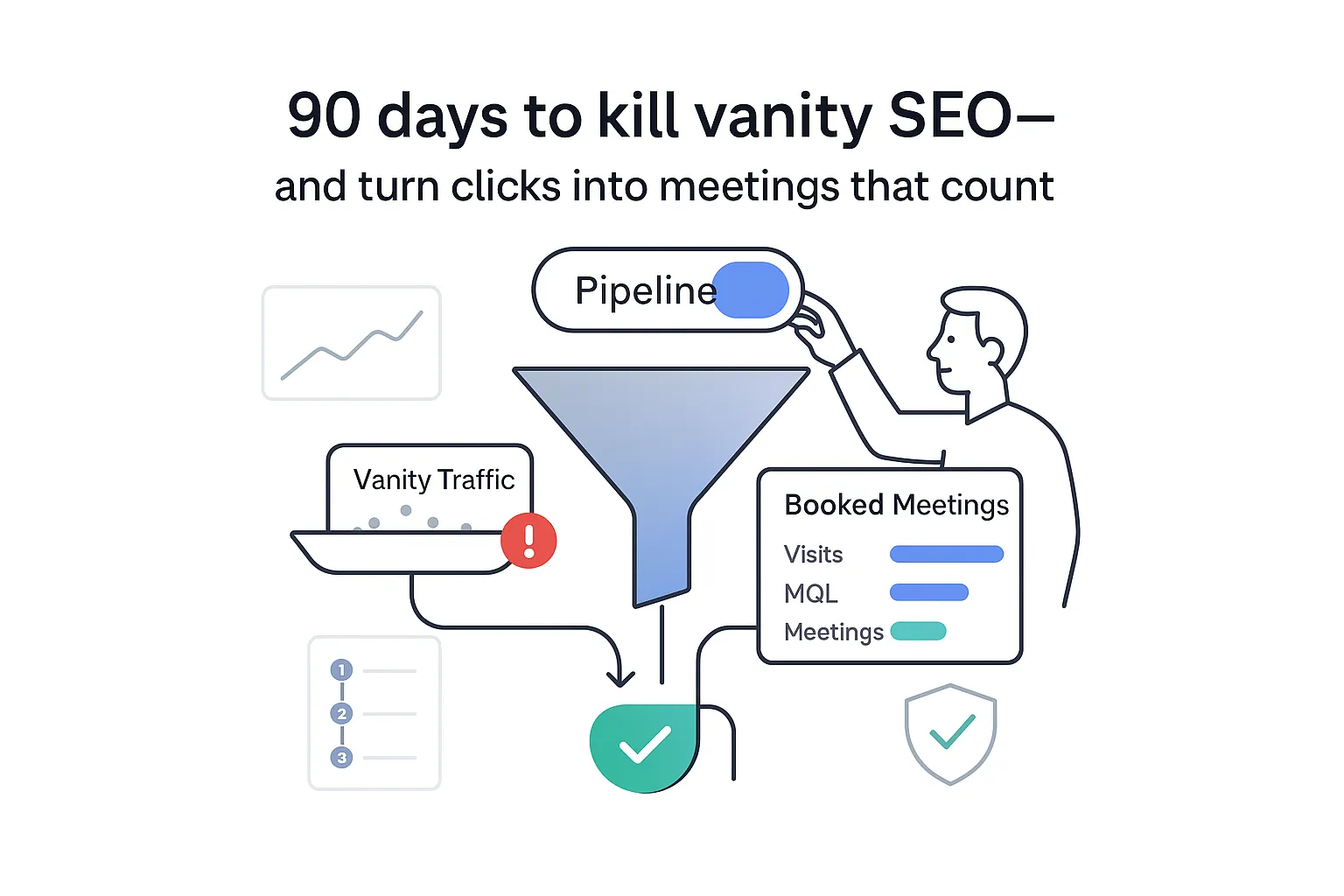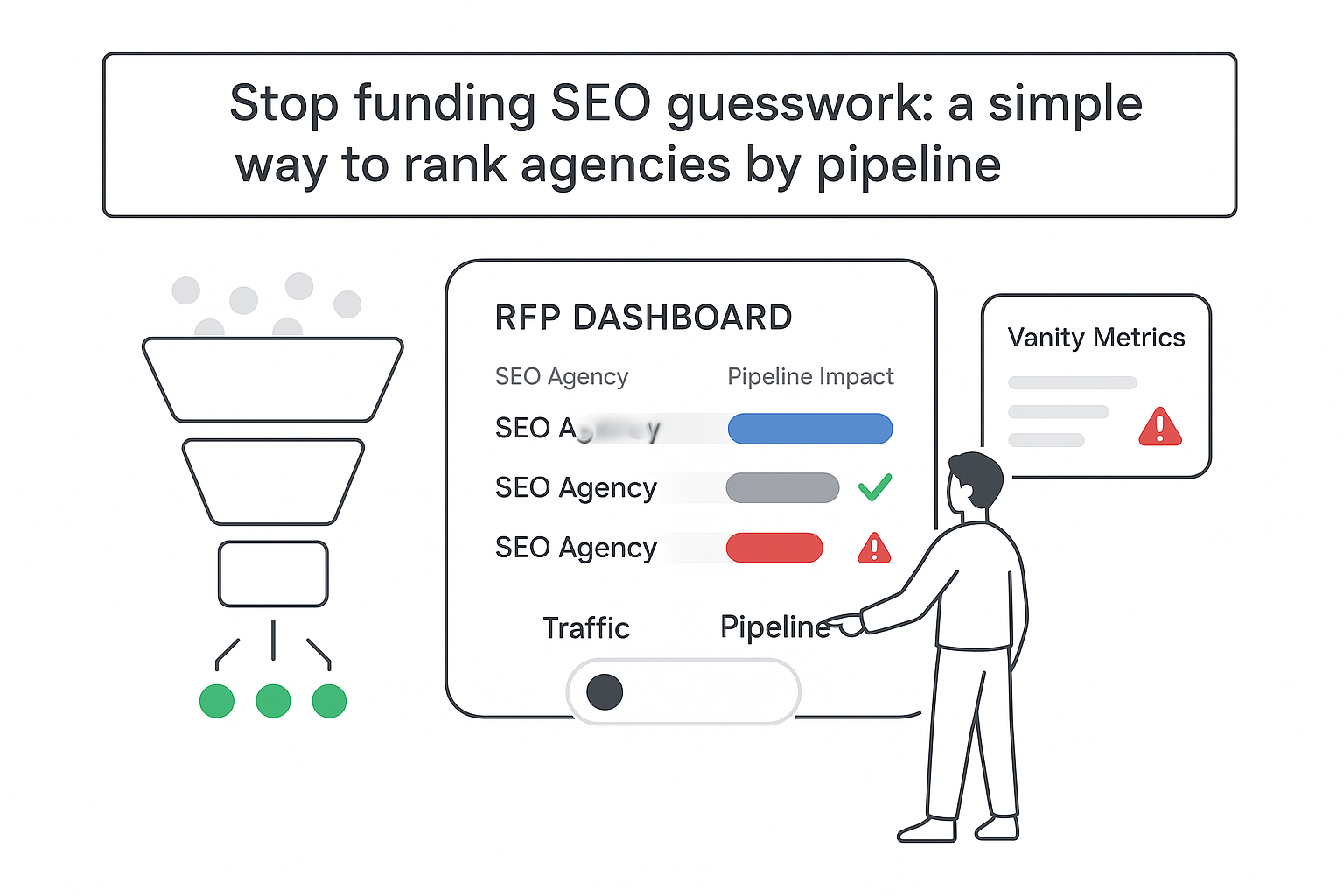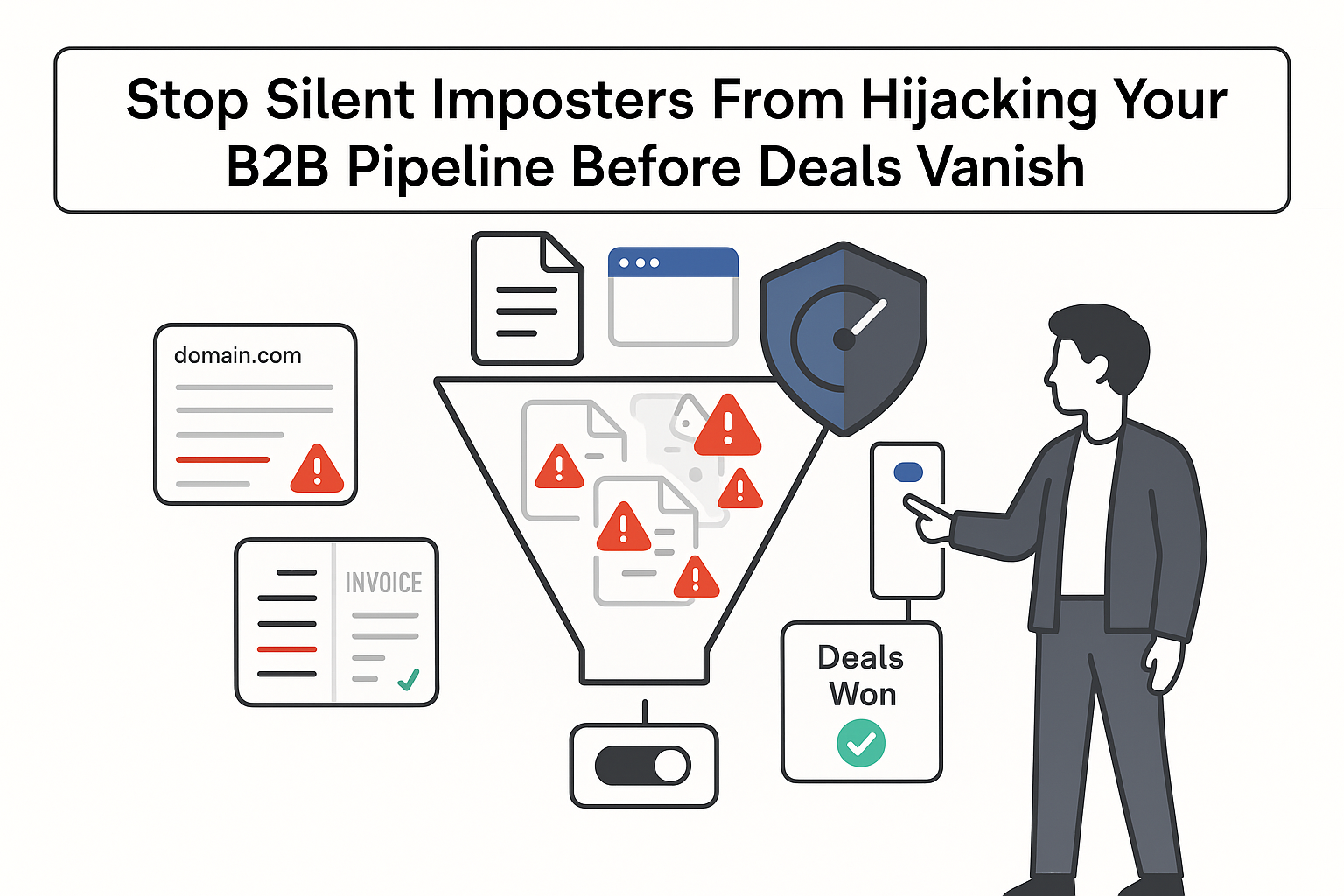If I run a B2B service company, I care less about vanity traffic and more about booked meetings and closed revenue. SEO can feel slow, yet a few focused moves turn search intent into sales conversations faster than most expect. The levers that matter are clear ICP targeting, pages built for conversion, healthy site fundamentals, and steady authority growth. I keep it simple, accountable, and measured against pipeline.
B2B SEO for service companies: the moves that actually move pipeline
In the first 90 days, I focus on what creates conversations now:
- Ship or improve high-intent pages: productized services, industry use cases, and comparison pages. These catch buyers near the bottom of the funnel.
- Fix the blockers: page speed, broken internal links, thin metadata, index and crawl issues. Quick fixes can unlock rankings I’ve already earned.
- Tighten conversions: short forms, clear CTAs on every commercial page, proof near the fold, and a direct path to book time.
Over 6 to 12 months, compound the gains:
- Publish a focused content hub: pillars and clusters around my ICP's (ideal customer profile's) real problems, not just keywords.
- Build authority: earn features and mentions on trusted industry sites, publish useful thought leadership, and participate in credible analyst or partner roundups.
- Expand SERP coverage: add use-case pages by vertical, "alternative vs. me" pages, and resource content for each member of the buying team.
The 80/20 levers I prioritize:
- ICP-driven keyword targeting: I start with the highest-margin services and the buying triggers my sales team hears every week.
- Conversion-focused page experience: clear promise, proof, and path.
- Technical fixes that improve crawl, speed, and index control.
- Authority building that earns real mentions and links, not fluff.
A simple KPI map I can explain to finance:
- Traffic → MQLs (marketing-qualified leads) → SQLs (sales-qualified leads) → revenue
- Organic sessions → demo or consult requests → qualified meetings → closed-won deals
- One weekly-reviewed dashboard from GA4 and Search Console, with supporting visibility data from a rank/backlink tool, tied to CRM for attribution
Putting it into practice: cadence, ownership, and clear reporting
Ownership and accountability make or break results. I use a working model that keeps momentum without micromanaging.
Cadence and SLAs
- Weekly standup (20 minutes): what shipped, what’s blocked, what’s next.
- Monthly review: plan vs. results in one brief doc - pages shipped, authority wins, issues fixed, and performance vs. forecast.
- SLAs I can uphold: first response to tickets within one business day, urgent site issues triaged same day, content edits within three business days.
Reporting that is clear
- One tracker for deliverables: pages, briefs, audits, authority mentions.
- One dashboard for outcomes: rankings on target terms, organic sessions, MQLs, SQLs, pipeline, revenue.
- Source of truth: GA4 for conversions, Search Console for query and page data, CRM or call tracking for attribution clarity.
Who owns what
- I own the ICP, the offer, and SME access.
- If I work with an external partner, they own the plan, execution, and results tied to agreed goals.
- Approvals are shared, with a simple SLA for feedback times to avoid bottlenecks.
Top SEO strategies for B2B businesses: build a hub, not a heap
The fastest-moving B2B sites publish around a clear structure that mirrors buyer research.
- Pillar and cluster content: one in-depth pillar per core problem my service solves, supported by clusters that answer specific questions, explain process, and share case stories.
- Productized service and use case pages: even for bespoke work, I shape top services as packages with scope signals, and add vertical- or role-based use cases so buyers see themselves.
- Comparison and alternative pages: buyers compare. I publish factual pages like "My approach vs. legacy approach," "Partner vs. internal hire," and "Option A vs. Option B."
- CRO that converts: short forms, persistent CTAs, trust badges, social proof above the fold, and a clear no-scroll value summary. I use behavioral analytics (heatmaps, recordings) to spot friction.
AI is fast, but brand safety matters. I add governance so content stays on voice and on point:
- Define voice and tone with examples of what to say and what to avoid.
- Model prompts with audience, goal, page type, and brand rules.
- Keep a human-in-the-loop: SME review on claims, editorial review on accuracy and legal.
- Check for plagiarism and hallucinations with similarity scans and source verification.
Systems like Digital Asset Management, Asset Workflow, and Content Workflow help teams manage approvals and maintain brand safety. For research on how organizations scale AI with governance, see State of DAM 2025.

My quick pre-publish checks
- Who is the page for, and what should they do next?
- One problem, one promise, one proof near the top.
- Clear data points with sources or CRM-backed insights.
- Brand phrases approved, claims legally safe, no fluff.
- Internal links to service pages and related resources.
- Final pass for readability and scannability.
Timeline for SEO results in B2B sectors
SEO is not overnight, but I can create measurable value every week with a firm plan.
Days 1 to 30
- Week 1: technical audit, analytics QA, baseline tracking, keyword and ICP mapping, page build list.
- Week 2: fix high-impact technical issues (index rules, sitemaps, 404s/redirects, speed basics). Draft two commercial page briefs.
- Week 3: publish or refresh two to three high-intent pages; implement CRO improvements; stand up the reporting dashboard.
- Week 4: begin outreach for existing assets and set digital PR angles; launch the first content pillar brief.
Days 31 to 60
- Ship two to four cluster articles per pillar; publish one comparison/alternative page; continue technical fixes including Core Web Vitals; source partner and customer proof for key pages.
Days 61 to 90
- Publish the second pillar hub with clusters; run an internal linking pass; earn early features via partners, associations, or trade media; review results against leading indicators.
Leading and lagging indicators to watch
- Weeks 1–4: better crawl health and index coverage, initial ranking lifts on branded/long-tail terms, early conversion-rate lift on high-intent pages.
- Weeks 5–8: growth in non-branded clicks, more top-20 rankings, demo/consult requests from target pages.
- Weeks 9–12: first top-5 rankings on lower-competition terms, growing MQLs tied to organic, first SQLs that sales confirms.
Months 4 to 6
- Add two more pillars, deepen clusters, publish new use case and industry pages; expect steady growth in top-10 rankings and organic pipeline share.
Months 7 to 12
- Keep the cadence: refresh winners, prune underperformers, expand authority with research pieces or surveys, and align with industry events; expect compounding results, with organic as a primary source of qualified meetings.
ROI calculation of SEO for B2B companies
I keep the math simple and visible, using formulas a finance lead can follow.
Core formulas
- Pipeline dollars = traffic to target page × CTR to lead page × CVR to MQL × SQL rate × ACV (average contract value)
- Payback period = cost ÷ gross profit from SEO-sourced deals per month
- LTV:CAC = lifetime value ÷ total acquisition cost
Example for a 100K MRR firm selling a 50K ACV service
- Target page gets 5,000 monthly sessions
- CTR to demo page is 8% → 400 visits
- CVR to MQL is 6% → 24 MQLs
- SQL rate is 40% → 9.6 SQLs
- Close rate is 25% → 2.4 deals
- Pipeline ≈ 9.6 × 50K = 480K; expected closed revenue ≈ 2.4 × 50K = 120K over the sales cycle
Cost lens
- Suppose monthly SEO cost is 12K and gross margin is 60%. Profit per 50K deal is 30K. Two deals in a quarter more than cover cost with margin left over.
How I keep projections honest
I use one spreadsheet with inputs for traffic, CTR, CVR, SQL rate, win rate, ACV, and costs, then view monthly and quarterly pipeline and revenue projections tied to GA4 and CRM data where possible.
Illustrative micro case
- Situation: mid-market IT services firm with 80K MRR and low organic lead flow.
- Actions: shipped three productized service pages, two comparison pages, fixed index bloat, added proof blocks, and earned four industry features.
- Outcomes (120 days): non‑branded clicks up 65%, MQLs from organic from 5 to 18 per month, two closed deals traced to comparison pages. Numbers vary, but quality plus focus is repeatable.
Cost-effective SEO for small B2B companies
Lean budgets don’t mean thin results; they demand ruthless focus.
Resourcing models I’ve seen work
- In-house lead plus specialist partners: one generalist or PM in-house, with an SEO operator and part-time technical specialist; add a niche-savvy writer.
- "Agency light": a fixed monthly scope for pages, authority work, and technical care with clear deliverables and a shared tracker.
- SME support: sales engineers or consultants contribute one hour per week to content; that hour often lifts quality more than any tool.
Minimum viable content cadence
- Two high‑intent pages per month (productized service, use case, or comparison).
- Two to three cluster articles per month tied to one pillar.
- One proof asset per month (case snippet, testimonial block, or short video quote).
Low‑effort authority plays
- Partner features on blogs or marketplaces.
- Contribute quotes to analyst newsletters and trade media.
- Associations and local chapters: webinars, briefings, event-page mentions.
- Publish 400‑word responses to industry research with a clear point of view.
Addressing past agency skepticism
- Ask for a 90‑day plan with weekly ship lists - no vague timelines.
- Require a live dashboard connected to GA4 and CRM.
- Approve a small number of pages and authority plays each month with clear goals per item.
- Write down assumptions and review them together next month.
Mapping work to pipeline stages that drive lead generation
I map my work to pipeline stages so I never lose sight of outcomes.
Technical SEO to keep the site fast and findable
- Plan: full audit in month one, quick wins in weeks two to three, Core Web Vitals improvements by month two, quarterly re‑audits.
- Response: critical issues within 24 hours, minor issues within 7 days.
- Reporting: crawl health, index status, speed scores, and an issue resolution log.
Intent-focused content to attract and convert
- Plan: briefs, drafts, and publishes on a set cadence - pillars, clusters, productized services, use cases, and comparison pages.
- Response: first draft within 7–10 days of brief approval; edits within 3 days.
- Reporting: published URLs, target queries, ranking movement, and assisted conversions.
Digital PR and links that actually help
- Plan: outreach list, pitches, features, and citations, with relevance over volume.
- Timing: first features by month two or three; monthly wins logged with URLs.
- Reporting: referring domains, topical relevance, and impact on target pages.
CRO to turn visits into meetings
- Plan: A/B tests on forms and CTAs, proof placement, and direct booking options.
- Cadence: one meaningful test live every two weeks.
- Reporting: conversion rates by page type, form completion time, and scroll depth.
Analytics and attribution so finance sees the lift
- Plan: GA4 events and conversions, Search Console integration, CRM field mapping, and a BI dashboard.
- Timing: dashboard live by week three; attribution QA monthly.
- Reporting: MQLs, SQLs, pipeline, revenue, and time to close for organic deals.
Single-threaded ownership
I assign one PM to own outcomes and communication. Less back-and-forth, fewer misses, more shipping.
B2B SEO agency reviews and testimonials: what real proof looks like
Proof beats promises. If I’m choosing a partner, I look for evidence that’s easy to verify.
What useful proof looks like
- Logos of clients in similar industries or deal sizes
- Short quotes tied to a KPI (MQL lift, pipeline created, or deals closed)
- Before-and-after snapshots of a service page or dashboard
- Links to live pages that now rank and convert
Formats I can replicate on my own site
- Quote card: one sentence, one metric, one name and title (with permission).
- Micro case: problem, action, result in three to five lines, with a real URL where possible.
- Timeline tile: what shipped in 30, 60, and 90 days with outcomes attached.
If I cannot share client names
- Use anonymized but specific data: industry, ACV range, timeframe, and exact metrics.
- Include a third-party trend: for example, Search Console screenshots with visible date ranges.
- Ask clients for LinkedIn comments that I can embed or cite with consent.
Two illustrative micro case formats
- Services automation provider: goal - reduce paid spend reliance. Actions - two service pages, one alternative page, ten cluster posts over 12 weeks. Results - 52% lift in non‑branded clicks and three SQLs traced to the alternative page by month four.
- Cybersecurity advisory: goal - higher‑quality leads. Actions - a compliance readiness pillar, four vertical use case pages, and site speed work. Results - 3x time on page on service URLs and two signed retainers within five months from organic touchpoints.
Bringing it all together
B2B SEO for service companies should feel like product work. I pick the few moves that matter, ship them on a steady cadence, and measure pipeline lift in plain numbers. I keep the brand voice tight, approvals quick, and the dashboard honest - and I stay focused on the next meeting booked and the next deal closed.







.svg)